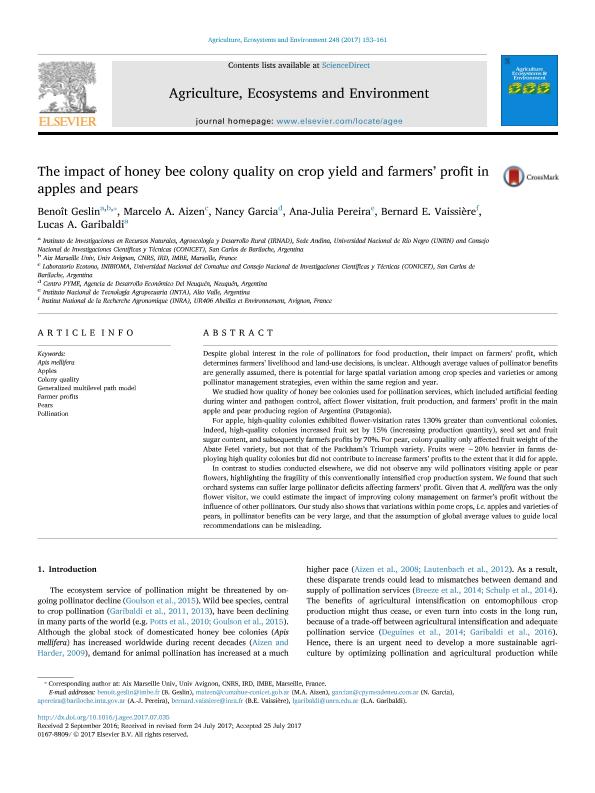Mostrar el registro sencillo del ítem
dc.contributor.author
Benoit Geslin, Mathias Yanin

dc.contributor.author
Aizen, Marcelo Adrian

dc.contributor.author
Garcia, Nancy
dc.contributor.author
Pereira, Ana Julia

dc.contributor.author
Vaissière, Bernard E.
dc.contributor.author
Garibaldi, Lucas Alejandro

dc.date.available
2018-01-10T17:59:39Z
dc.date.issued
2017-08
dc.identifier.citation
Aizen, Marcelo Adrian; Garibaldi, Lucas Alejandro; Vaissière, Bernard E.; Pereira, Ana Julia; Garcia, Nancy; Benoit Geslin, Mathias Yanin; et al.; The impact of honey bee colony quality on crop yield and farmers’ profit in apples and pears; Elsevier Science; Agriculture, Ecosystems and Environment; 248; 8-2017; 153-161
dc.identifier.issn
0167-8809
dc.identifier.uri
http://hdl.handle.net/11336/32838
dc.description.abstract
Despite global interest in the role of pollinators for food production, their impact on farmers’ profit, which determines farmers’ livelihood and land-use decisions, is unclear. Although average values of pollinator benefits are generally assumed, there is potential for large spatial variation among crop species and varieties or among pollinator management strategies, even within the same region and year. We studied how quality of honey bee colonies used for pollination services, which included artificial feeding during winter and pathogen control, affect flower visitation, fruit production, and farmers’ profit in the main apple and pear producing region of Argentina (Patagonia). For apple, high-quality colonies exhibited flower-visitation rates 130% greater than conventional colonies. Indeed, high-quality colonies increased fruit set by 15% (increasing production quantity), seed set and fruit sugar content, and subsequently farmeŕs profits by 70%. For pear, colony quality only affected fruit weight of the Abate Fetel variety, but not that of the Packham’s Triumph variety. Fruits were ∼20% heavier in farms deploying high quality colonies but did not contribute to increase farmers’ profits to the extent that it did for apple. In contrast to studies conducted elsewhere, we did not observe any wild pollinators visiting apple or pear flowers, highlighting the fragility of this conventionally intensified crop production system. We found that such orchard systems can suffer large pollinator deficits affecting farmers’ profit. Given that A. mellifera was the only flower visitor, we could estimate the impact of improving colony management on farmer’s profit without the influence of other pollinators. Our study also shows that variations within pome crops, i.e. apples and varieties of pears, in pollinator benefits can be very large, and that the assumption of global average values to guide local recommendations can be misleading.
dc.format
application/pdf
dc.language.iso
eng
dc.publisher
Elsevier Science

dc.rights
info:eu-repo/semantics/openAccess
dc.rights.uri
https://creativecommons.org/licenses/by-nc-sa/2.5/ar/
dc.subject
Apis Mellifera
dc.subject
Generalized Multilevel Path Model
dc.subject
Colony Quality
dc.subject
Pollination
dc.subject.classification
Otras Ciencias Biológicas

dc.subject.classification
Ciencias Biológicas

dc.subject.classification
CIENCIAS NATURALES Y EXACTAS

dc.title
The impact of honey bee colony quality on crop yield and farmers’ profit in apples and pears
dc.type
info:eu-repo/semantics/article
dc.type
info:ar-repo/semantics/artículo
dc.type
info:eu-repo/semantics/publishedVersion
dc.date.updated
2017-12-15T14:31:36Z
dc.journal.volume
248
dc.journal.pagination
153-161
dc.journal.pais
Países Bajos

dc.description.fil
Fil: Benoit Geslin, Mathias Yanin. Universidad Nacional de Rio Negro. Sede Andina; Argentina. University Avignon; Francia. Consejo Nacional de Investigaciones Científicas y Técnicas; Argentina
dc.description.fil
Fil: Aizen, Marcelo Adrian. Consejo Nacional de Investigaciones Científicas y Técnicas. Centro Científico Tecnológico Conicet - Patagonia Norte. Instituto de Investigaciones en Biodiversidad y Medioambiente. Universidad Nacional del Comahue. Centro Regional Universidad Bariloche. Instituto de Investigaciones en Biodiversidad y Medioambiente; Argentina
dc.description.fil
Fil: Garcia, Nancy. Agencia de Desarrollo Económico del Neuquén; Argentina
dc.description.fil
Fil: Pereira, Ana Julia. Instituto Nacional de Tecnología Agropecuaria; Argentina. Consejo Nacional de Investigaciones Científicas y Técnicas; Argentina
dc.description.fil
Fil: Vaissière, Bernard E.. Institut National de la Recherche Agronomique; Francia
dc.description.fil
Fil: Garibaldi, Lucas Alejandro. Universidad Nacional de Rio Negro. Sede Andina; Argentina. Consejo Nacional de Investigaciones Científicas y Técnicas; Argentina
dc.journal.title
Agriculture, Ecosystems and Environment

dc.relation.alternativeid
info:eu-repo/semantics/altIdentifier/doi/http://dx.doi.org/10.1016/j.agee.2017.07.035
dc.relation.alternativeid
info:eu-repo/semantics/altIdentifier/url/http://www.sciencedirect.com/science/article/pii/S016788091730333X
Archivos asociados
